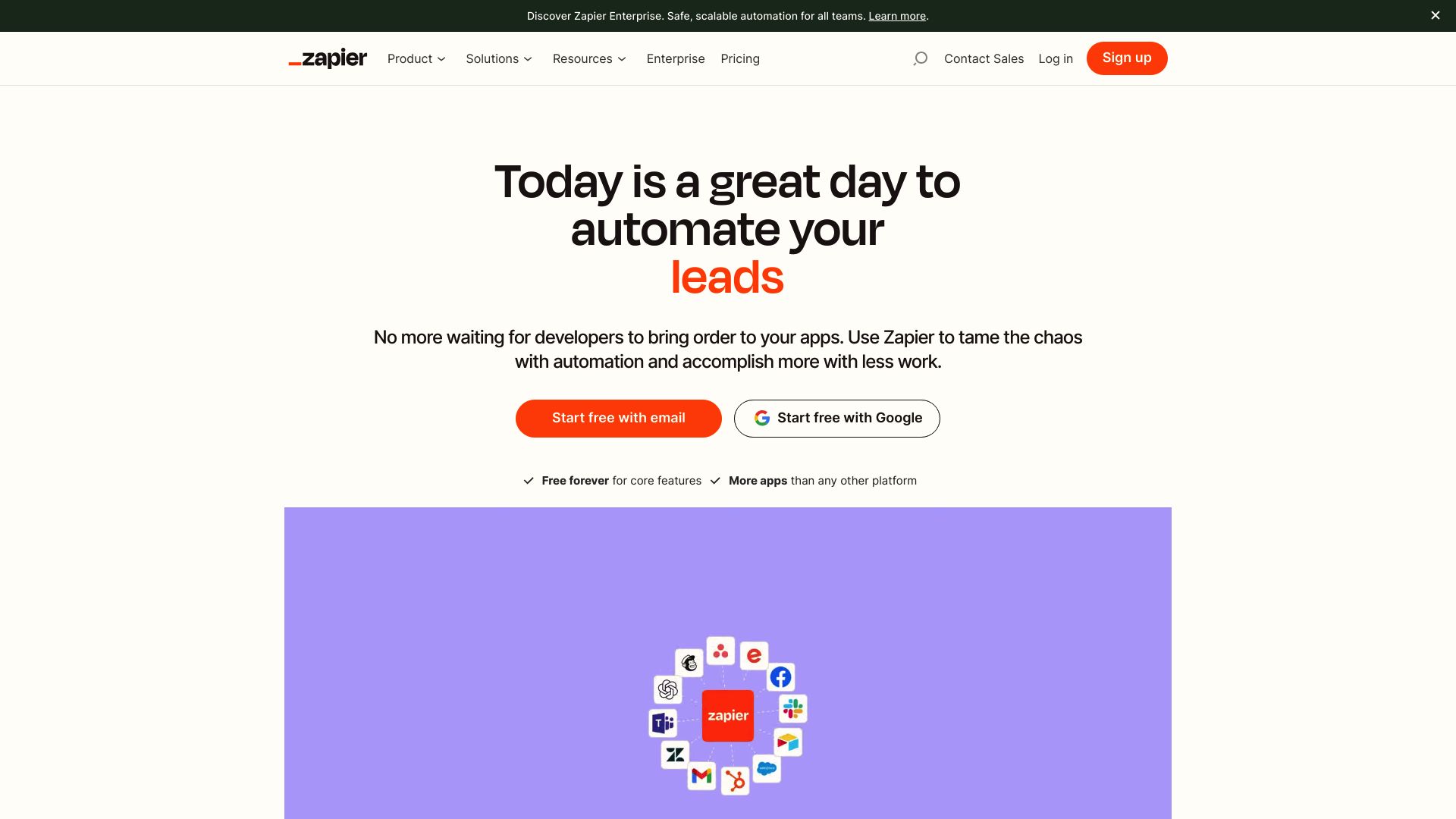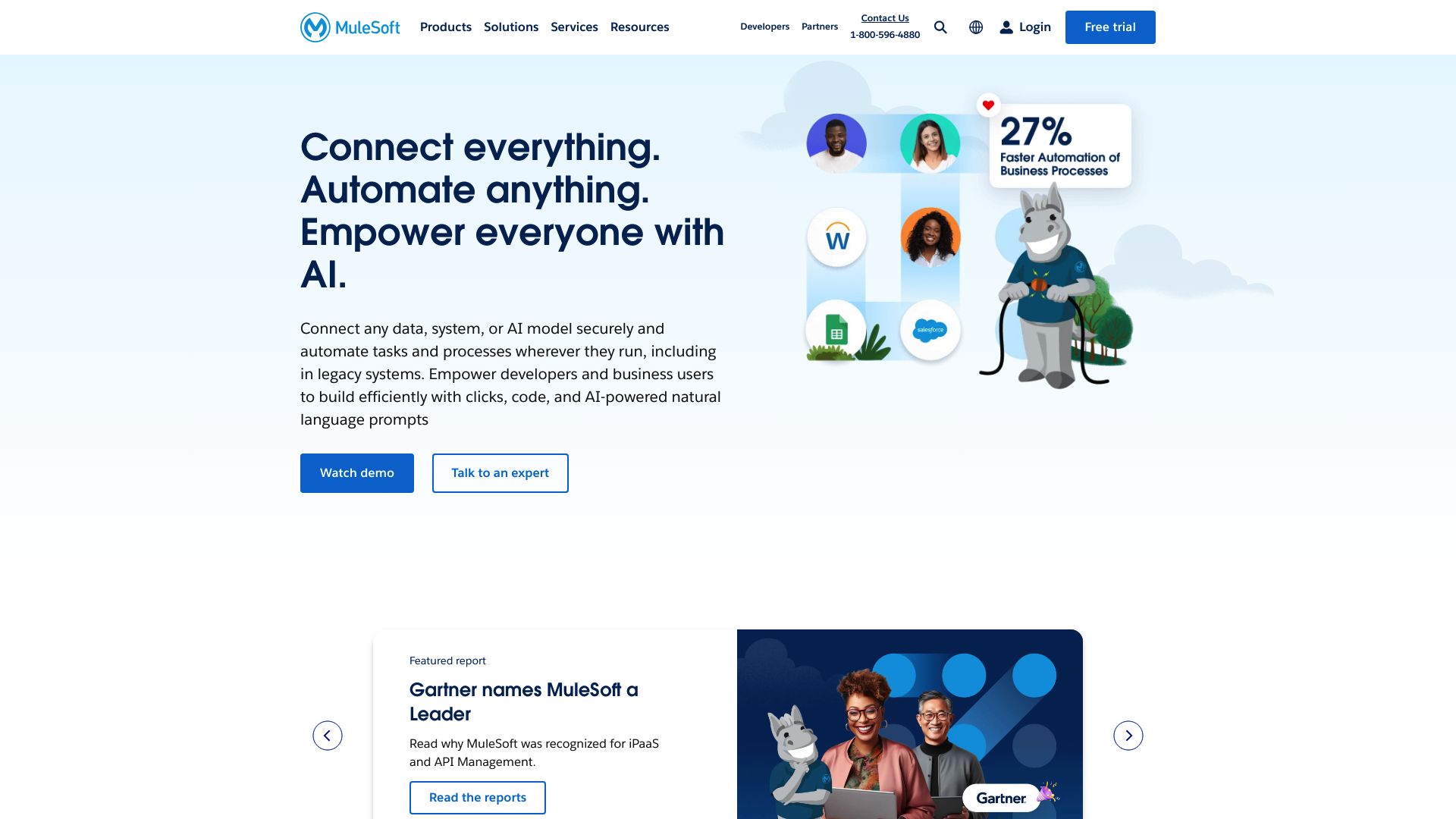The AI platform landscape offers a diverse array of tools for businesses seeking to harness the power of automation and integration. This comparison delves into the capabilities of Zapier vs. Mulesoft, and SmythOS, three distinct platforms each catering to different needs in the AI and automation space. Zapier shines with its user-friendly approach to connecting web applications, while Mulesoft provides robust enterprise-grade integration solutions.
SmythOS emerges as a versatile AI-first platform, combining ease of use with advanced capabilities. This analysis explores each platform’s strengths, limitations, and ideal use cases, offering insights to help developers, business leaders, and AI enthusiasts make informed decisions about which tool best aligns with their specific requirements and goals.
Zapier Overview
Zapier empowers users to connect and automate workflows across thousands of apps without coding. The platform excels at streamlining repetitive tasks and data flows between popular business tools and services.

At its core, Zapier offers a visual workflow builder for creating automated processes called Zaps. These Zaps connect triggers in one app to actions in another, enabling tasks like automatically saving email attachments to cloud storage or creating tasks from form submissions. The platform supports over 6,000 app integrations, covering major business tools across categories like productivity, marketing, and customer support.
Zapier offers a visual workflow builder for creating automated processes called Zaps. These Zaps connect triggers in one app to actions in another…
Zapier caters to both non-technical users and developers. Its no-code interface allows anyone to build basic automations, while more advanced users can leverage JavaScript for custom logic and API integrations. The platform provides environments for development and production, ensuring smooth workflow creation and deployment.
While Zapier excels at app integrations, it lacks some advanced AI capabilities. The platform doesn’t offer features like hosted AI agents, autonomous problem-solving, or natural language processing. Its strength lies in connecting existing tools rather than building conversational or decision-making AI systems.
Zapier’s scalability and team collaboration features make it suitable for businesses of all sizes. The platform offers robust logging and monitoring tools, essential for troubleshooting and optimizing automated workflows. However, users should consider their specific AI and integration needs when evaluating Zapier against more AI-focused platforms.
Mulesoft Overview
Mulesoft delivers a comprehensive integration platform designed to connect data, applications, and devices across on-premises and cloud environments. The Anypoint Platform empowers organizations to design, build, and manage APIs, enabling seamless connectivity and digital transformation.

Mulesoft’s flagship product, Anypoint Platform, offers a full-lifecycle API management solution. It includes tools for API design, development, deployment, and monitoring. The platform caters to developers, IT managers, and business leaders seeking to streamline operations and enhance digital capabilities.
Mulesoft delivers a comprehensive integration platform designed to connect data, applications, and devices across on-premises and cloud environments.
Key features of Mulesoft’s offering include API-led connectivity, integration and automation for AI, and robust security measures. The platform leverages Einstein AI to boost developer productivity, generating MuleSoft flows and enabling intelligent data mapping. Anypoint Flex Gateway ensures secure API management, crucial for organizations handling sensitive data.
While Mulesoft excels in enterprise-grade integration, it may present a steeper learning curve for smaller teams or those new to API development. The platform’s extensive capabilities can be overwhelming for simpler projects. Additionally, pricing may be a consideration for budget-conscious organizations.
Mulesoft’s integration with existing systems proves valuable for large enterprises with complex IT landscapes. The platform supports various APIs and automation tools, facilitating connections with diverse business applications. This flexibility positions Mulesoft as a strong contender in the competitive integration platform market, particularly for organizations prioritizing scalability and comprehensive API management.
Feature Comparison
Zapier and Mulesoft offer distinct approaches to integration and automation, with key differences in their core components and security features. Zapier excels in user-friendly, no-code integrations between popular web apps, while Mulesoft provides a robust enterprise-grade integration platform.
Zapier’s visual workflow builder enables quick setup of automated tasks without coding. However, it lacks advanced AI capabilities and hosted agents. Mulesoft’s Anypoint Platform offers full API lifecycle management but requires more technical expertise. Mulesoft integrates Einstein AI for enhanced productivity, a feature absent in Zapier.
Security-wise, Mulesoft’s Anypoint Flex Gateway provides enterprise-level API security and governance. Zapier offers basic data encryption and OAuth support, but lacks the comprehensive security features of Mulesoft. We offer constrained alignment and advanced security measures, surpassing both platforms in this crucial area.
Feature Comparison Table
| Zapier | Mulesoft | SmythOS | |
|---|---|---|---|
| CORE FEATURES | |||
| AI Agents | ❌ | ✅ | ✅ |
| Hosted Agents (Dev, Production) | ❌ | ✅ | ✅ |
| Memory & Context | ❌ | ❌ | ✅ |
| Autonomous Agents | ❌ | ✅ | ✅ |
| Explainability & Transparency | ❌ | ❌ | ✅ |
| Multimodal | ❌ | ✅ | ✅ |
| Problem-Solving Capabilities | ❌ | ❌ | ✅ |
| Multi-Agent Collaboration | ❌ | ✅ | ✅ |
| Human-AI Interaction | ❌ | ❌ | ✅ |
| Audit Logs for Analytics | ✅ | ❌ | ✅ |
| Agent Work Scheduler | ❌ | ✅ | ✅ |
| SECURITY | |||
| Constrained Alignment | ❌ | ✅ | ✅ |
| Data Encryption | ✅ | ❌ | ✅ |
| IP Control | ❌ | ✅ | ✅ |
| COMPONENTS | |||
| Foundation AIs | ❌ | ✅ | ✅ |
| Huggingface AIs | ❌ | ❌ | ✅ |
| Zapier APIs | ✅ | ❌ | ✅ |
| All other APIs, RPA | ✅ | ❌ | ✅ |
| Classifiers | ❌ | ✅ | ✅ |
| Logic | ❌ | ❌ | ✅ |
| Data Lakes | ❌ | ✅ | ✅ |
| DEPLOYMENT OPTIONS (EMBODIMENTS) | |||
| Deploy as Site Chat | ❌ | ✅ | ✅ |
| Deploy as Scheduled Agent | ❌ | ❌ | ✅ |
| Deploy as GPT | ❌ | ✅ | ✅ |
| Scalability | ✅ | ❌ | ✅ |
| DATA LAKE SUPPORT | |||
| Hosted Vector Database | ❌ | ✅ | ✅ |
| Sitemap Crawler | ❌ | ❌ | ✅ |
| YouTube Transcript Crawler | ❌ | ❌ | ✅ |
| URL Crawler | ❌ | ❌ | ✅ |
| PDF Support | ❌ | ❌ | ✅ |
| Word File Support | ❌ | ✅ | ✅ |
| TXT File Support | ❌ | ✅ | ✅ |
Best Alternative to Zapier and Mulesoft
SmythOS emerges as the superior alternative to Zapier and Mulesoft, offering a comprehensive AI agent automation platform that bridges the gap between integration and artificial intelligence. We provide a powerful solution that combines the best of both worlds — seamless integrations and advanced AI capabilities.
Our drag-and-drop interface surpasses Zapier’s ease of use while delivering far more sophisticated AI functionality. Unlike Zapier’s limited workflow automations, SmythOS enables users to create intelligent agents that can handle complex tasks autonomously. We offer hosted agents for both development and production environments, multi-agent collaboration, and human-AI interaction — critical features missing from Zapier.
SmythOS emerges as the superior alternative to Zapier and Mulesoft, offering a comprehensive AI agent automation platform that bridges the gap between integration and artificial intelligence.
Compared to Mulesoft’s enterprise integration platform, SmythOS provides a more accessible and versatile solution for building AI-powered automations. While Mulesoft focuses primarily on API management, we offer a complete ecosystem for developing, deploying, and managing AI agents across various use cases. Our platform includes features like memory and context retention, explainability, and problem-solving capabilities that extend beyond Mulesoft’s offerings.
SmythOS stands out with its extensive AI model support, including integration with Hugging Face models, which neither Zapier nor Mulesoft provide. We also offer unparalleled flexibility in deployment options, allowing users to deploy agents as APIs, webhooks, chatbots, or scheduled tasks. This versatility, combined with our robust security features like constrained alignment and data encryption, makes SmythOS the ideal choice for businesses seeking a powerful yet user-friendly AI automation platform.
Conclusion
Zapier, Mulesoft, and SmythOS each offer unique approaches to integration and automation, catering to different business needs and technical expertise levels. Zapier excels in user-friendly, no-code integrations between popular web apps, making it ideal for small to medium-sized businesses seeking quick automation solutions. Mulesoft provides a robust, enterprise-grade integration platform with full API lifecycle management, suitable for large organizations with complex IT ecosystems.
However, SmythOS stands out as the superior choice, combining the best of both worlds while adding powerful AI capabilities. Our platform offers an intuitive drag-and-drop interface for creating sophisticated AI workflows, rivaling Zapier’s ease of use. At the same time, we provide enterprise-level features like multi-agent orchestration and versatile deployment options, matching and exceeding Mulesoft’s capabilities.
SmythOS’s unique strengths lie in its AI-first approach, extensive integration ecosystem, and unparalleled flexibility. We support over 300,000 integrations and various AI models, enabling users to create and deploy AI agents across multiple platforms effortlessly. Our ’Create Once, Deploy Anywhere’ philosophy ensures maximum versatility, allowing businesses to leverage AI in ways previously unimaginable.
For those ready to experience the future of AI-powered automation and integration, we invite you to explore our diverse range of AI-powered agent templates. These templates cover multiple business categories and offer a glimpse into the transformative potential of SmythOS. To take the next step, create a free SmythOS account and start building AI agents with no time limit. Discover how SmythOS can revolutionize your workflow and unleash unprecedented levels of productivity and innovation.